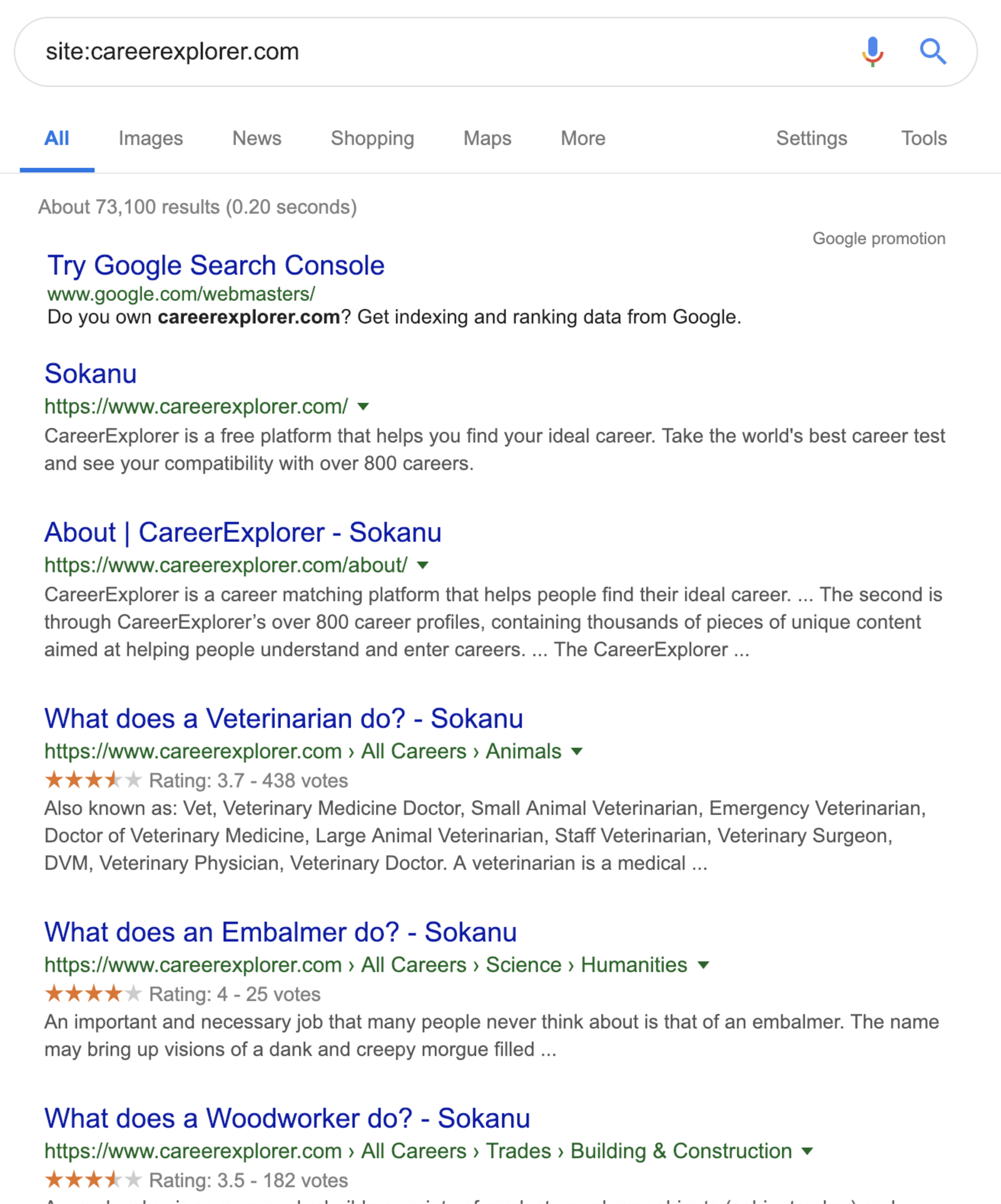As part of a larger corporate re-structuring and re-brand, we wanted to move our six year old web presence onto a new domain. We did our research, we read the warnings, we knew that changing domains would likely hurt in the short term, and despite a lack of resources for transitions of our magnitude, we still pressed ahead, convinced if we did everything right we’d come out of it fine.
For reference, CareerExplorer (formerly Sokanu) is a tool that uses psychometrics and machine learning to match users to careers. Much of our traffic is SEO-based, both from users who are searching explicitly for a career test, or from users who are simply searching for more data on a career that they’re interested in.
Having not had much of a reference point for sites of our size, wanted to share our experience with others. In Part 1 of an on-going series, we’ll be sharing our steps and missteps, along with what you can expect to happen with Google when migrating a large domain.
Our Preparation
After thorough research, we did everything we thought important for our domain transition. In short, we:
- Created and verified our new domain in Search Console
- Updated our content, branding, and internal linking to reflect the new domain
- Set up 301 redirects on our old domain to the new one
- Used Google Search Console’s Change of Address tool to explicitly tell them about our intentions
- Submitted updated sitemaps to Google
- Contacted our close partners to have them update their linkbacks to our new domain
- Notified active users that they would be logged out during the transition (due to cookies being domain specific)
- Instituted a feature deployment freeze on external-facing pages to minimize any chance of Google getting confused by us making multiple changes at once*
*We have new features and a re-design of many of our external pages lined up for release, but have been holding off on doing so as most guides on domain swaps have led us to believe that making major changes isn’t smart during a transitionary period like ours.
After a couple of dry runs, and with a strange mix of confidence and trepidation, we pulled the trigger. Our 301s worked perfectly. Traffic remained steady. Google was crawling us much more frequently. Frankly, for the first few days we were surprised with how smoothly everything was going. Our rankings and traffic were consistent, and by all other metrics we were continuing to do fantastically. For a brief second we thought maybe we got off scot-free.
The Dip Begins
Unfortunately that enthusiasm was short-lived. It took about a week, but we finally began to see the actual outcomes of the domain transition:
The orange trendline shows our traffic the week before the domain switch. The blue trendline shows it the week after.
We began to see a steady 65% decline in week-on-week traffic, as Google began to transition some of our listings from our old domain to our new one. Frankly, this was expected (although we would’ve liked a less dramatic fall), and thankfully we still had predictable direct traffic to prevent the numbers from completely bottoming out. The rankings for many of our top keywords now look like below (we swapped our domain on the 6th, which is followed by a lot of missing data due to our rank monitoring tool):
Search Console Quirks
Probably the most frustrating part for us has been the lack of insight into exactly what’s going on behind the curtains of Google’s crawlers. As recommended by Google, we submitted our new sitemaps for validation, but received this very reassuring error:
Obviously this caused some panic among the team, but we tested the sitemaps multiple times and validated that they were accessible and accurate (and they had just recently been indexed fine by our old property, further validating that point).
When switching back to the old Search Console interface, we can actually see that these maps are all actually pending rather than failing, which gave us a little bit of reassurance that this is more of a bug in Search Console during the transition rather than an error on our end:
Google is Generally Still Quite Confused
What’s been unexpected is how long it’s taking for Google to register that we’ve actually changed our name, despite marking the domain as changed and updating all relevant <title> attributes. This results in silly things like below appearing in search results:
It seems as though Google automatically interprets the name of your site and appends it to your <title> (in some cases). Amusingly, it even does this if you explicitly follow their pattern as we do on some pages:
Link Building
One aspect of our transition plan that we unfortunately haven’t done enough of yet is link building on the new domain. In general, it’s quite wise to issue a press release and contact partners to update link backs, while also generating new content linking to your new domain. There’s a few reasons we haven’t done much of this yet, but it’s sure to be one of the main things you can do to keep your SEO on-track after a domain swap.
Next Steps
We’ll be back with Part 2 when we have more to share, but for now we’re just staying calm and monitoring our traffic. Things are moving along, and as more and more of our pages are indexed and Google finishes grappling with our new domain, we’re confident we’ll have some positive trends to share along with some sage advice for others thinking of taking on a domain swap of this magnitude.








